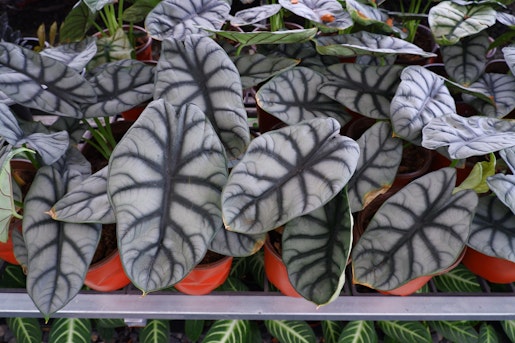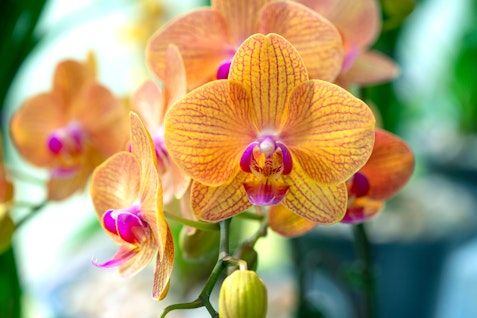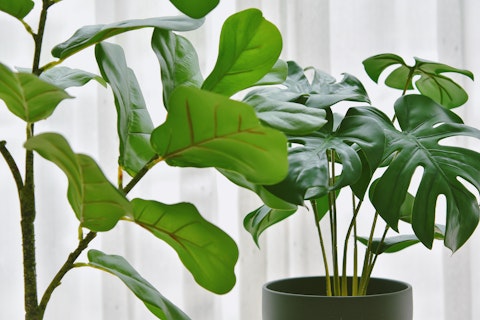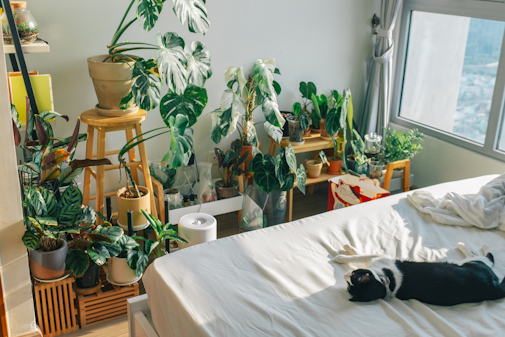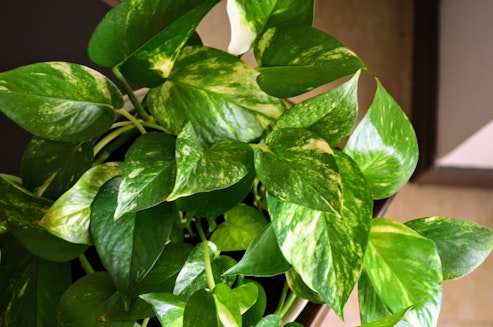
- Home
- Common Interior Plants

So you’re thinking about starting an indoor plant collection? Or perhaps you’re just looking at a single plant? Whether you want one or two to fill space in your home or office, or one-thousand to study meticulously and spectate every millimetre of growth for yourself, look no further.
Here is a complete guide to the common interior plants, and a great place to start for the budding indoor botanist to get the low-down on the what, where and why of the indoor plant world!
Benefits of Interior Plants
Interior plants are a selection of live plants that are regularly found in commercial or residential spaces. They are usually selected for a few reasons, namely: their visual appeal (whether that be colour, size or other aesthetic qualities), their resilience to indoor conditions, or their simple care requirements. Over time, a lot of plants that are marketed as indoor plants have increased in popularity and are now considered to be ‘common interior plants’.
These common plants come with many benefits that improve the quality of the space they are in! They are often visually stunning and each one unique, meaning they bring a flair to any space they are placed in, whether that be adding striking colours, or fascinating and expressive shapes - and they only get better as they grow!
There is a lot of psychological research that links natural spaces, and the colour green, to productivity and positive thinking, as well as creating a calming environment. And finally, but not exhaustively, they help with regulating time and developing good habits or managing a schedule. The regular attention that plants require can help to practise routine building, break up your day or is a healthy and even a great way to introduce young ones to responsibility!
Simply put, bringing plants into indoor spaces can remove us from the white and grey of modern life, and bring nature back into our everyday lives! Indoor plants are an investment that help us grow and learn, bring us joy, and get better with age! What’s not to love?!
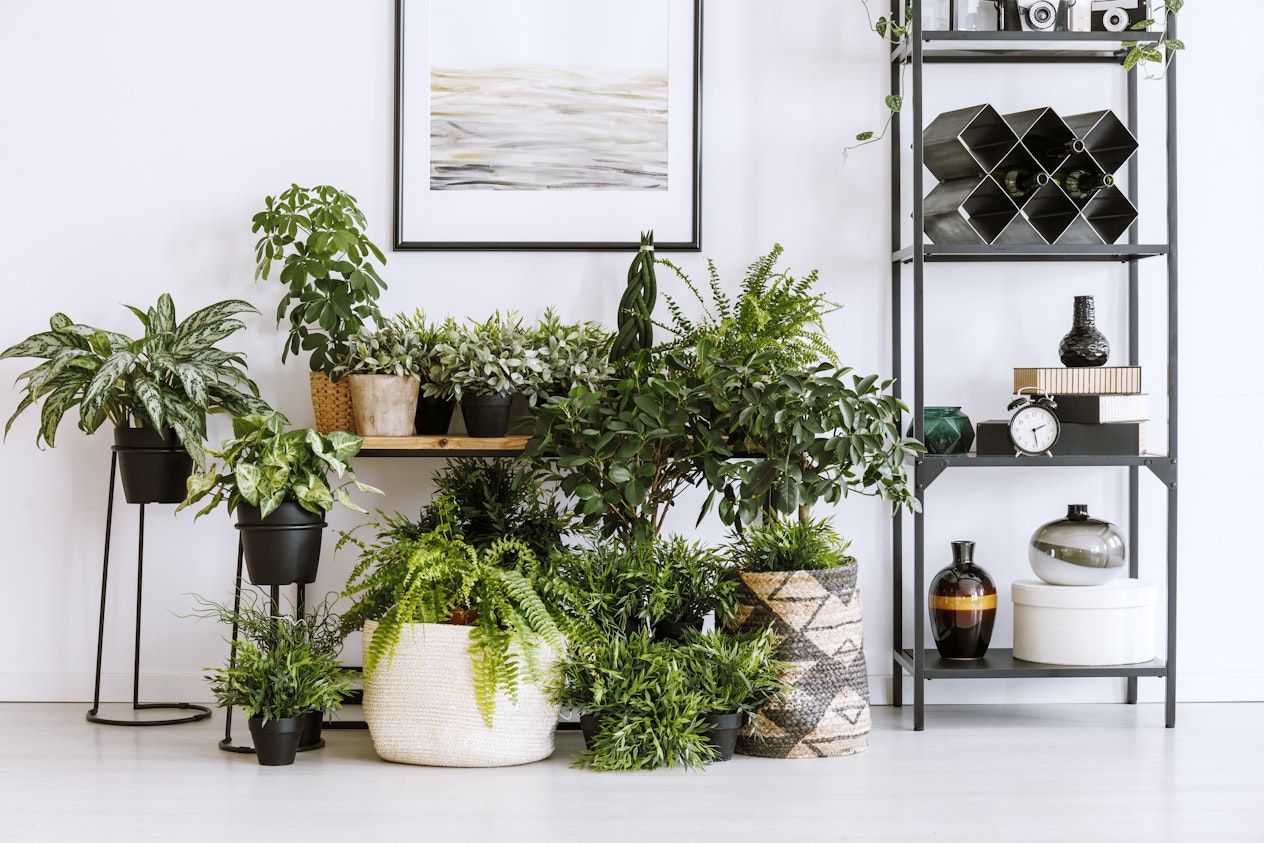
Characteristics of Common Interior Plants
The common interior plants are selected based on several characteristics. These characteristics help them to be able to thrive in a home as they would in the wild! Resultantly, indoor plants tend to be tropical and subtropical plants, due to their tolerance to the higher and more consistent temperatures we have in our homes!
The features that make these plants perfect for inside the home, are the same that ensure that these plants thrive when we take them home! These characteristics are as follows:
Long life span - Most indoor plants have long life cycles, and have the potential to survive in the home for anywhere between 2 and 100 years and even beyond that in some cases! This means that they are great long-term features in any residential or commercial space, and with the right care, give back for a very long time! This separates them from cut flowers and floral bouquets that typically decline within a few weeks!
Evergreens - Most indoor plants keep their foliage throughout the winter, unlike many of the trees and shrubs that exist in our local parks and gardens. This is because in their native homes, the winters do not get cold or dark enough for these plants to need to conserve any energy. That means they are visually stunning all year round!
Variety of Shapes & Sizes and Colours - Plants are by no means a sea of oval, green leaves! They come in an assortment of colours and shapes, sometimes just on a single plant! In terms of looks, there is certainly a plant for everyone, and the amount of varieties is increasing all the time!
Hardy & Resilient - Of course, there are groups of specialist plants that require specific care to help thrive, but most of the common interior plants are easily looked after and require minimal maintenance to keep healthy!
Adaptability to Indoor Environments
Indoor plants are selected based on their adaptability to indoor environments. The truth is that these plants have not become especially accustomed to the conditions of the home, but are from the simplest environments to replicate in the home!
Windows, even the largest and brightest, filter out a certain amount of light, meaning that the majority of indoor plants are from conditions of reduced sunlight so that the conditions in indoor spaces are already preferable!
And with the understanding of substrates, and developments in various technologies such as fertilisers and pest control, a lot of factors that are determinate to a plant’s health in the wild are easily controlled in the home!
Growth Habits and Sizes
Plants come in a variety of shapes and sizes, meaning there really is a plant for most places in the home! The most popular are as follows.
Climbers - Plants that grow with ascending vines, often attaching themselves to walls or well-positioned structural fittings using twisting aerial roots or small affixing support vines! These look great when incorporated into a space with a tall structure like a pillar or a staircase wall!
Trailers - Plants that hang down in descending vines, often happy to hang in the air! These look great when placed in a ceiling hanging planter, or cascading down the side of a taller piece of furniture like a bookcase or a shelving unit!
Terrestrial plants - The traditional style, known by most! Terrestrial plants grow upwards from a substrate base and are often contained within pots. They come in a variety of sizes - and as a result, can be used as a standing centrepiece or to fill any smaller space as desired!
Epiphytes - These are plants that grow upon other plants in the wild, and can be displayed to mimic this indoors! That is not to say that this is required, a lot of epiphyte plants are grown in special substrate in regular pots, but a plant bound to a piece of natural wood certainly makes for a fascinating and natural-looking display!
Leaf Colours, Shapes and Textures
Plants come in a variety of colours. These can be monochromatic or display a huge variety within one plant! This means that plants can be selected to fit a certain style or theme, or can invite an explosion of mixed colours into your indoor space!
Colourful leaves - While lots of plants come in a variety of greens, it is easy to find plants with white, red, purple, orange and yellow leaves! Some plants have different coloured leaves, stems and sometimes leaves with opposing colours on the top and underside of the leaf respectively! There is no concise way to demonstrate the array of colour combinations that plants can bring into your home! The fact is, the options are endless!
Variegation - The modern plant-growing industry has been able to catch chance mutations in cultivated plants and reproduce them to get truly unique variations in plants. These often marbling multicoloured patterns upon leaves and stems are known as variegation, and cause the most striking and beautiful leaves you will have ever seen!
Blooms - The majority of houseplants are actually flowering plants, aside from ferns and some shrubby and woody plants. This means that under the right conditions a lot of the common interior plants can bloom and often demonstrate flowers of great variety in shape, colour and scent! Some are very difficult to encourage to bloom, but others are pretty reliable such as Spathiphyllum (Peace Lilies), Anthurium andraeanum (Flamingo Plants), Hoya (Wax Plants) and many orchid species!
As well as being host to fascinating colours, the diversity of plants is displayed nicely in the assortment of shapes their leaves come in as well! Plants are often prized for their leaf shapes, and they can differ so dramatically that two plants can look entirely separate from each other and behave as a completely different decorative feature!
Succulents - Popular due to their minimal need for attention, succulent plants have thick and juicy leaves, often compared to looking like gummy sweets! These include Aloe and Crassula (Jade plants).
Bushy - Often stemmed with multiple thin leaves with hundreds of tiny leaflets coming from them, giving them a ‘bushy’ or ‘hairy’ look! These are great space fillers and add real variety to any collection. Examples include Asparagus setaceus (Asparagus fern) and Nephrolepis exaltata (Boston Fern).
Large Leaved Plants - Plants with large leaves often make for a centrepiece of a collection, or as an aesthetic feature by themselves. Large leaves can really draw attention and commonly have an assortment of colours, patterns or shapes, like a living work of art! Examples include Dieffenbachia (Dumb cane), Monstera deliciosa (Swiss Cheese Plant)
Spiky - Like succulents, ‘spiky’ plants are popular for their low-maintenance nature and interesting shapes and colours. The most famous example is the humble cactus! But there are others too.
Unique - There are so many variations in leaf shape. There are species of plant with entirely unique shapes that are not seen in any other plant. Philodendron is a genus of plant with countless different species of completely different shapes. Pilea peperomioides (Chinese Money Plant) has perfectly circular leaves, and the leaves of Platycerium bifurcatum (Staghorn fern) are long with prongs at the end like an antler! There is no end to the diversity of leaf shapes, insofar that to group them into categories is an impossible feat!
Textures
When it comes to texture, the same is true as for the previous two sections. There is really no way to express the limitless nature of plant diversity, and texture is no exception! A few of the most common examples are:
Grassy - some plants grow long leaves that are often smooth to the touch, like running your hand along the lawn in summer! Dracaena marginata (Dragon Tree) and Chlorophytum comosum (Spider Plants) famously have this kind of texture!
Fluffy/Fuzzy - Plants that are bushy in shape often have a light fluffy texture to them, comparable to cotton wool or candy floss! Asparagus setaceus (Asparagus fern) is a great example of this! Similarly, plants can have a light, peachy fuzz to them! Certain Hoya species have this fuzzy texture, as well as Platycerium bifurcatum (Staghorn Fern)
Velvety - Some plants have a light velvety texture, and even reflect light In a similar way! These are fascinating and provide absolute sensory satisfaction if gently stroked! Certain Philodendrons (hederaceum/micans, Verrucosum) and a few orchids have this texture.
Waxy - A large number of plants have a thick waxy texture to them, that is almost irresistible to squish (although it's probably best you don’t!). This texture is what gives Hoya their common name ‘Wax plant’.
Common Interior Plant Species
A few of the more common interior plant species are listed below. If you’re here for a quick glance or a skim-read, check this list out for some inspiration. If you have a bit more time, there is a more in-depth and specific list below! Some common species are:
Cactus - Plants from the family Cactaceae, that commonly grow as thick, robust stems with spikes growing from them. They are usually reliably low-maintenance.
Tree species - Large plants that usually have one or more thick woody stems (Ficus, Pachira, Citrus, Olea)
Succulents - Plants that have a singular, squidgy form or multiple thick squidgy and almost gummy-looking leaves. They are usually reliably low-maintenance (Aloe, Crassula, Aeonium, Echeveria).
Aroids - Plants of the family Araceae, that are commonly climbers or trailers and demonstrate an interesting array of leaf shapes and colours. They are usually fairly resilient and can tolerate a variety of environments (Philodendron, Monstera, Anthurium, Spathiphyllum).
Air plants - A genus of Bromeliads called Tillandsia that have no root system, and are commonly grown in small glass bottles, sat on a surface, or hanging from something. They require no soil and minimal watering.
Orchids - Usually light-tolerant epiphyte plants with thick waxy leaves and unbelievable blooms that can be reliably encouraged year upon year.
Dracaena - A genus of grassy plants that require minimal watering and can survive reliably in low light conditions.
Palms - An assortment of plants that grow from long thin trunks or stems and boast grassy growth sat on the top. Great as a central feature, light and drought tolerant and usually fairly low maintenance (Yucca, Howea, Chamaedora, Chrysalidocarpus).
Hoya - A genus of plants that have rocketed into popularity in recent years due to their interesting variety of leaf shapes, colours and incredible waxy blooms that often smell unbelievable!
Ferns - A series of leafy plants that grow from a central crown and are tolerant of a lot of varying conditions (Asplenium, Platycerium, Phlebodium, Microsorum)
Prayer Plants - Several genera of brightly coloured plants that point their leaves upwards overnight (Maranta, Calathea, Stromanthe, Ctenanthe)
Factors Affecting Common Interior Plants
Here are some factors that can affects common interior plants, from light to temperature and humidity.
Light Requirements
Plants require light to survive. It provides them with energy through photosynthesis that allows them to take up the water and nutrients it needs to grow. Resultantly, all plants are required to see natural light in order to thrive, with the only exception being certain artificial lights that provide them with adequate light.
Sadly, any light will not do as halogen bulbs are ineffective and the temperature causes plants to scorch and overheat, while the majority of white LEDs do not emit strong enough light for the plant. We have a post about this, that talks about what light plants need, how much and what grow lights to get here if you want to read something a little more in depth!
Before we move on, it is also important to note that plants generally require different light levels seasonally, with the winters being darker and days shorter, plants should be moved towards light sources, with the opposite being true in the bright, long days of summer.
Temperature and Humidity Preferences
Plants generally have variable temperature and humidity requirements. The majority of houseplants have gained popularity due to their lack of specialist care, so it is unlikely that temperature and humidity will be a significant factor in the keeping of common plants.
It is important to note that due to being mostly tropical plants, indoor plants will struggle in very low temperatures, especially delicate plants like Fittonia and orchids; an exception being Cacti and desert succulents, most of which experience very low temperatures every night in their natural habitat.
For the simplest solution, understanding the specific needs of your plant can help you to gauge what kind of temperature and humidity it needs, and such can easily be measured using affordable and accessible equipment! Unfortunately, misting plants does not help mimic natural humidity. A spray from a bottle is unlike the constant stream of temperate water vapour that these plants would be getting in the wild. If humidity is an absolute requirement, getting a humidifier is a much more effective option, and often doesn’t set you back too much either!
Water Requirements
Again, it is most effective to approach watering by understanding the plant you are keeping and what it requires. Certain plants (Cacti and Succulents) like to completely dry out before being watered again, others (Carnivorous plants) prefer a consistent wetness. Indoor plants can sit anywhere between these two extremes and every plant is different.
As a non-specific solution, as it is best to avoid over watering plants and the consequences can be much harder to fix than those of underwatering, if you are unsure whether or not to water a plant, don’t.
Secondly, plants go through seasonal changes and often require less water during winter months. A lot of tropical plants enter dormancy during shorter days and don’t take up much water at all, so water sparingly! Plants like cacti and succulents can go months without a single drink throughout the winter. Further, how much water plants take up is directionally proportional to the amount of light they’re getting. Plants in brighter spots will need watering more regularly than plants in darker spots.
Soil Types and Drainage
We can split soil types into categories. In reality, plants all require slightly different potting environments, but these can be simplified to four main categories:
- Terrestrial - chunky mix that retains water - for typical earth growing plants (Monstera, Maranta, Calathea, Begonia, Anthurium, Spathipyllum, some Hoya, some Philodendron).
- Succulent - a stoney mix that allows for lots of drainage and quick drying - For plants with thick, succulent leaves or stems (Cacti, Aloe, Sedum, Crassula, Aeonium, some Euphorbia, Echeveria, Kalanchoe, Agave).
- Epiphytic - a chunky mix with lots of aeration so that roots have regular access to oxygen and nutrients. For plants that naturally grow upon other plants or woody surfaces (Most Orchids: Phalaenopsis, Dendrobium, Cattleya, Brassia, Oncidium; Most Bromeliads, some Hoya, some ferns).
- Marsh plants - a thick, low nutrient mix that retains excessive amounts of water for constant hydration and humidity (Carnivorous Plants: Dionaea, Nepenthes, Sarracenia, Pinguicula).
You can read more about this and how to create the perfect potting mix for these plants here.
The final, but most important thing to know when thinking about potting is drainage. Plants require water to be able to soak through their soil and out of the bottom. If water is allowed to pool at the base of their container this will cause mould growth, fungi and the potential for pests and root rot.
A solution for this is to pot plants into a plastic nursery pot before putting them in a ceramic or decorative container, otherwise a stoney drainage layer made of large slate chunks or LECA pebbles can work effectively too!
Popular Common Interior Plants
Dracaena syn. Sansevieria trifasciata (Snake Plant) - A long-leaved, semi-succulent which is reliable, hardy and survives in low light conditions.
Tradescantia zebrina (Spiderwort/Wandering Dude) - A fast-growing and colourful, medium-light plant that can be trained to climb, trail or carpet!
Cacti - A renowned spikey plant that needs minimal attention and likes bright light and comes in a vast array of shapes, colours and sizes!
Zamioculcas zamiifolia (ZZ Plant) - A great beginner plant. Requires minimal maintenance and survives happily in low-light environments. Grows thick, chunky stems with lots of ovate waxy leaves protruding from it.
Ficus lyrata (Fiddle Leaf Fig) - Indoor tree with large, violin-shaped leaves. Happy in medium to bright indirect sunlight.
Spathiphyllum wallisii (Peace Lily) - A hardy and beautiful low-light plant which can reliably flower all year round. The dark green leaves contrast wonderfully with striking white flowers.
Ficus elastica (Rubber Plant) - A popular indoor tree that grows vertically, sporting large, ovate leaves. Can be easily found in an assortment of fascinating colours.
Hoya (Waxplant) - A genus of semi-epiphytic plants that come in a variety of leaf shapes, sizes, textures and colours and are often popular for their unique look when compared to other species. They are also adored for their beautiful and fragrant blooms.
Dracaena marginata (Dragon Tree) - A tall, vertically growing, grassy tree that is available in a variety of colours, and adds a tropical feeling to a space without the need for tropical conditions!
Monstera deliciosa (Swiss Cheese Plant) - One of the most popular houseplants globally, enormous heart-shaped leaves with fenestrated edges, creating a plant so spectacular it's like a work of art in its own right!
Monstera adansonii (Monkey Mask) - A small, climbing plant with delicate holed leaves. Its quick growth makes it popular as a small to medium-sized feature plant.
Aloe vera - A chunky succulent that has long arms growing from a central crown. The sap inside the arms has a large number of benefits and can be used in lots of different ways!
Hedera helix (English Ivy) - A fast-growing ornamental plant that can be trained to trail or hang from a high place. Easily found in a variety of colours, shapes and patterns.
Crassula ovata (Jade Plant) - A hardy and reliable succulent that develops thick waxy leaves, and goes a deep purple when exposed to sunlight. Popular due to its ability to thrive with minimal attention.
Epipremnum aureum/ Scindapsus pictus (Pothos) - Two plants of the same family used in a similar way! Grows in long vines with large, heart-shaped leaves. These can be trained to grow up something or hang down, and can be used as a compliment to a high piece of furniture, hung from a ceiling or trained up a moss pole to act as a large, feature plant. They both come in a large variety of styles and colours.
Chlorophytum comosum (Spider Plant) - A low-maintenance, fast-growing plant with a grassy texture. These are often found in a combination of white and green colours, and grow long arms with tiny versions of itself that can be snipped and re-planted to create a new plant!
Tillandsia (Air Plants) - A genus of epiphytes that require no potting soil or medium to keep them contained, and with regular spraying or soaking can grow in really unique ways. Often kept in glass bottles or attached to decorative containers like sea shells or stones.
Philodendron scandens (Heartleaf Philodendron) - A climbing or trailing vine plant with heart-shaped leaves. The most popular cultivar “Brazil” has variegated leaves of yellow, green and sometimes white.
Pilea peperomioides (Chinese Money Plant) - A small standing plant with small, round leaves and red stems/petioles. Popular as a beginner houseplant due to its prolific growth habits.
Aglaonema commutatum (Chinese Evergreen) - A diverse aroid that comes in a huge array of colours, and survives in lower light conditions. Popular for their brightly coloured foliage and minimal care requirements.
Chamaedorea elegans (Parlour Palm) - A grassy, tropical palm that grows quickly and does well in medium light. Popular as large, feature houseplants.
Streptocarpus ionanthus (African Violet) - A small, furry textured plant with dark green-coloured ovate leaves. Grows well in medium light and can flower reliably all year round. Flowers come in an assortment of colours!
Anthurium andraeanum (Flamingo Flower) - A small aroid that flowers in multiple colours and has large, bright, standing flowers that really capture the attention. Happy in medium light and flowers all year round.
Phalaenopsis amabilis (Moth Orchid) - The most popular species of Orchid, blooming with tens of flowers that can be found in a huge array of colours, prized for their ornamental appeal. While they flower for only a few months of the year, the flowers can come back every year.
Platycerium bifurcatum (Staghorn Fern) - A large, epiphytic fern that grows two different types of leaves: large green ones that catch the sun’s rays and circular round ones that protect the base of the plant. They are prized for their ability to grow under low light and produce really unique-shaped leaves.
Asplenium antiquum (Birds Nest Fern) - A type of fern that grows rigid, lime-green leaves from a central crown. Different cultivars have produced a variety of really interesting leaf shapes that make this plant so popular, as well as their low maintenance and light requirements.
Care and Maintenance of Common Interior Plants
As mentioned above, different plants require vastly different care. Resultantly, there is no one way to care for all plants, as useful as that would be! I have put together a table that notes the plants listed above, what their light, water and soil requirements are, so that you can have an idea of what to expect if you have one of them in mind!
|
Plant |
Watering Frequency |
Soil Type |
Light |
|
Dracaena trifasciata |
Let dry between watering. |
Terrestrial: Well draining, chunky soil. |
Low to bright-indirect light, with the plant being more productive in medium and above. |
|
Tradescantia zebrina |
Keep soil moist but not sitting in water. |
Terrestrial: Well draining, chunky soil. |
Medium light. |
|
Cacti |
Let dry completely between watering. No more than once a month, even in summer months. |
Succulent: Very well draining, mineral soil. |
Bright indirect light. |
|
Zamioculcas zamifolia |
Let dry between watering. |
Terrestrial: Well draining, chunky soil. |
Medium to low light, with the plant being more productive in medium. |
|
Ficus lyrata |
Keep soil moist but not sitting in water. |
Terrestrial: Well draining, chunky soil. |
Bright indirect light. |
|
Spathiphyllum walisii |
Keep soil moist but not sitting in water. |
Terrestrial: Well draining, chunky soil. |
Medium to low light, with the plant being more productive in medium. |
|
Ficus elastica |
Keep soil moist but not sitting in water. |
Terrestrial: Well draining, chunky soil. |
Bright indirect light. |
|
Hoya |
Keep soil moist but not sitting in water. |
Terrestrial: Well draining, chunky soil. |
Medium to bright-indirect light, with the plant being more productive in brighter light. |
|
Dracaena marginata |
Let dry between watering. |
Terrestrial: Well draining, chunky soil. |
Medium light. |
|
Monstera deliciosa |
Keep soil moist but not sitting in water. |
Terrestrial: Well draining, chunky soil. |
Medium light. |
|
Monstera adansonii |
Keep soil moist but not sitting in water. |
Terrestrial: Well draining, chunky soil. |
Medium light. |
|
Aloe vera |
Let dry completely between watering. No more than once a month, even in summer months. |
Succulent: Very well draining, mineral soil. |
Medium to bright-indirect light, with the plant being more productive in brighter light. |
|
Hedera helix |
Keep soil moist but not sitting in water. |
Terrestrial: Well draining, chunky soil. |
Medium to bright-indirect light. |
|
Crassula ovata |
Let dry completely between watering. No more than once a month, even in summer months. |
Succulent: Very well draining, mineral soil. |
Medium to bright-indirect light, with the plant being more productive in brighter light. |
|
Epipremnum aureum |
Keep soil moist but not sitting in water. |
Terrestrial: Well draining, chunky soil. |
Medium to low light, with the plant being more productive in medium. |
|
Scindapsus pictus |
Keep soil moist but not sitting in water. |
Terrestrial: Well draining, chunky soil. |
Medium to low light, with the plant being more productive in medium. |
|
Chlorophytum cosmoum |
Keep soil moist but not sitting in water. |
Terrestrial: Well draining, chunky soil. |
Medium to low light, with the plant being more productive in medium. |
|
Tillandsia |
Soak in water once a fortnight, or spray every 3 days. |
Epiphyte: No soil, or soil with no water retention. |
Bright indirect light. |
|
Philodendron scandens |
Keep soil moist but not sitting in water. |
Terrestrial: Well draining, chunky soil. |
Medium to low light, with the plant being more productive in medium. |
|
Pilea peperomioides |
Keep soil moist but not sitting in water. |
Terrestrial: Well draining, chunky soil. |
Medium light. |
|
Aglaonema commutatum |
Keep soil moist but not sitting in water. |
Terrestrial: Well draining, chunky soil. |
Medium to low light, with the plant being more productive in medium. |
|
Chamaeodora elegans |
Keep soil moist but not sitting in water. |
Terrestrial: Well draining, chunky soil. |
Medium to low light, with the plant being more productive in medium. |
|
Streptocarpus ionanthus |
Keep soil moist but not sitting in water. |
Terrestrial: Well draining, chunky soil. |
Medium to low light, with the plant being more productive in medium. |
|
Anthurium andreanum |
Keep soil moist but not sitting in water. |
Terrestrial: Well draining, chunky soil. |
Medium to low light, with the plant being more productive in medium. |
|
Phalenopsis amabilis |
Water until it comes through the drainage holes, and allow it to drain. Keep moist but not sitting in water. |
Epiphyte: Light/loose bark or moss. |
Medium to bright-indirect light, with the plant being more productive in brighter light. |
|
Platycerium bifurcatum |
Keep soil moist but not sitting in water. |
Terrestrial: Well draining, chunky soil. |
Medium to low light, with the plant being more productive in medium. |
|
Asplenium antiquum |
Keep soil moist but not sitting in water. |
Terrestrial: Well draining, chunky soil. |
Medium to low light, with the plant being more productive in medium. |
Pruning and Trimming
Pruning can be very important for plant care for a number of reasons. Firstly, it can help to control a plant’s shape and size. If a leaf grows in a way that is undesired, whether it be in terms of where it is, or how big its getting, it can be removed to keep the plant’s size down.
Secondly, pruning can remove unwanted or damaged leaves, which is good for the aesthetic quality of the plant, but also stops a build-up of organic matter in the soil, which can lead to fungal and pest problems.
Finally, pruning is useful in a lot of woody-stemmed plants for encouraging bushier growth, as a large proportion of plants when cut, grow two shoots from the cut. Pruning is good for a plant's health and great for managing a plant’s size and shape. But note that pruning can also be a risk to a plant’s health if done too much. As a general rule, try to never prune more than 30% of a plant’s foliage off at once.
Fertilisation and Nutrient Requirements
In the wild, plants are adapted to survive and benefit from the complex ecosystems in the soil they inhabit. That is a number of microbes, small insects, fungi and other plants constantly taking things away from and giving things back to the soil chemistry of the land. Unfortunately, these conditions are difficult to replicate inside a pot without introducing a lot of yucky things in. Instead, we use plant food or fertiliser!
Most plants need fertiliser to keep their soil healthy and nutritious. Fertilisers compain a number of chemicals, but the most important being three specific ones: nitrogen, phosphorus and potassium. These are abbreviated as NPK. Certain plants prefer higher levels of some and not the others, such as Orchids like a bit more potassium and Carnivorous plants a little more nitrogen. But these are often sold as species-specific fertilisers.
As for when to fertilise, the best results are produced when mixing a small amount of fertiliser in with your water and adding in response to active growth. If your plant is growing, then adding a bit of fertiliser helps that growth come in big and strong. Continue this through the longer days of spring and summer!
Start to taper off in the autumn and stop altogether through the winter when your plants go dormant. If your plant is under a grow light, or in a controlled environment, it can handle fertilisation all year round! But make sure not to overdo it. Too many nutrients can lead to excess growth of various microbes and fungus in the soil, which leads to nasty smells and nastier pests!
Conclusion
Hopefully this guide can act as the place to start on your plant journey. Indoor plants have a huge number of benefits, and can bring nature back into the grey concrete of the modern world. While they do require different care, there is a large number of plants that are accessible and manageable for beginners, with all the benefits of the others!
If you like what you’ve read, or a certain plant catches your eye, check our blog for other posts that may be of interest to you, whether it be for practical reasons or just for the pursuit of knowledge! Happy growing!
Jonathan Davies
Jonny has worked at Root since May 2023. His love for plants was inherited initially from his grandparents and parents, but really took off once he moved into his own place, where he started picking up small plants and was fascinated by watching how they grow and change over time. Jonny has a degree in Archaeology and Classics from the University of Sheffield, and a masters in Egyptology from Swansea University, where he primarily focused on garden culture in the ancient world, which he has managed to extend to a PhD thesis in the University of Liverpool, where he has been able to combine his love for plants with his love for ancient language and culture. Jonny loves being in the natural spaces around North Wales and Cheshire where he used to go growing up, and often spends hours examining the plants and trees, and kicking up the leaf litter searching for mushrooms and insects. He is fascinated most by plant biology, taxonomy and learning about ecosystems and interactions between plants and their environmental counterparts, and enjoys tending to his varied array of houseplants, and ongoing ‘plant projects’, such as growing plants from seeds and creating living epiphyte displays. Aside from his green thumb, his other interests include: art, reading, listening to and playing music in the company of his cats, Spooky and Boo.
More by Jonathan DaviesRelated Articles
View all articles
